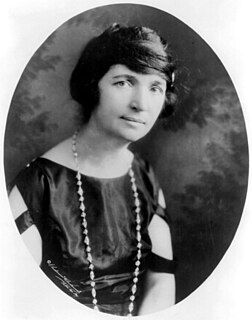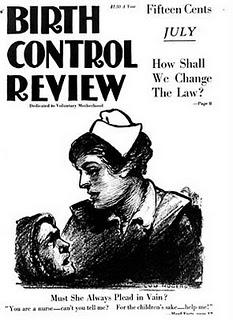The Voluntary Parenthood League (VPL) was an organization that advocated for contraception during the birth control movement in the United States. The VPL was founded in 1919 by Mary Dennett. [1] The VPL was a rival organization to Margaret Sanger's American Birth Control League. The VPL lobbied to change anti-contraception laws. [2] In 1925 the VPL merged with the American Birth Control League.

Margaret Higgins Sanger was an American birth control activist, sex educator, writer, and nurse. Sanger popularized the term "birth control", opened the first birth control clinic in the United States, and established organizations that evolved into the Planned Parenthood Federation of America.

The combined oral contraceptive pill (COCP), often referred to as the birth control pill or colloquially as "the pill", is a type of birth control that is designed to be taken orally by women. It includes a combination of an estrogen and a progestogen. When taken correctly, it alters the menstrual cycle to eliminate ovulation and prevent pregnancy.

The Comstock Laws were a set of federal acts passed by the United States Congress under the Grant administration along with related state laws. The "parent" act was passed on March 3, 1873, as the Act for the "Suppression of Trade in, and Circulation of, Obscene Literature and Articles of Immoral Use". This Act criminalized usage of the U.S. Postal Service to send any of the following items:

Family planning services are “the ability of individuals and couples to anticipate and attain their desired number of children and the spacing and timing of their births. It is achieved through use of contraceptive methods and the treatment of involuntary infertility.” Family planning may involve consideration of the number of children a woman wishes to have, including the choice to have no children and the age at which she wishes to have them. These matters are influenced by external factors such as marital situation, career considerations, financial position, and any disabilities that may affect their ability to have children and raise them. If sexually active, family planning may involve the use of contraception and other techniques to control the timing of reproduction.
Prior to the 20th century, three major branches of Christianity—Catholicism, Orthodoxy and Protestantism—as well as leading Protestant reformers Martin Luther and John Calvin generally held a critical perspective of birth control. Among Christian denominations today, however, there is a large variety of positions toward birth control.

Within the framework of the World Health Organization's (WHO) definition of health as "a state of complete physical, mental and social well-being, and not merely the absence of disease or infirmity," reproductive health, or sexual health/hygiene, addresses the reproductive processes, functions and system at all stages of life. UN agencies claim sexual and reproductive health includes physical, as well as psychological well-being vis-a-vis sexuality.
Clarence James Gamble, was an American doctor and the heir of the Procter and Gamble soap company fortune. He was an advocate of birth control and eugenics, and founded Pathfinder International.

EngenderHealth is a 501(c)(3) nonprofit organization based in Washington, D.C., active in women's health and sexual and reproductive health (SRH) operating in nearly 20 countries Africa, Asia, and the Americas. The organization was established in 1943 and provided access to voluntary surgical contraception in the United States during its first 25 years. It has since expanded its mission to "training health care professionals and partnering with governments and communities to make high-quality family planning and sexual and reproductive health services available-today" and in the future.

The National Birth Control League was a United States organization founded in the early 20th century to promote the education and use of birth control.
Reproductive justice is "the human right to maintain personal bodily autonomy, have children, not have children, and parent the children we have in safe and sustainable communities," according to SisterSong Women of Color Reproductive Justice Collective, the first organization founded to build a reproductive justice movement. In 1997, 16 women-of-color-led organizations representing four communities of color – Native American, Latin American, African American, and Asian American – launched the nonprofit SisterSong to build a national reproductive justice movement. Additional organizations began to form or reorganize themselves as reproductive justice organizations starting in the early 2000s.

Birth control, also known as contraception, anticonception, and fertility control, is a method or device used to prevent pregnancy. Birth control has been used since ancient times, but effective and safe methods of birth control only became available in the 20th century. Planning, making available, and using birth control is called family planning. Some cultures limit or discourage access to birth control because they consider it to be morally, religiously, or politically undesirable.

The womb veil was a 19th-century American form of barrier contraception consisting of an occlusive pessary, i.e. a device inserted into the vagina to block access of the sperm into the uterus. Made of rubber, it was a forerunner to the modern diaphragm and cervical cap. The name was first used by Edward Bliss Foote in 1863 for the device he designed and marketed. "Womb veil" became the most common 19th-century American term for similar devices, and continued to be used into the early 20th century. Womb veils were among a "range of contraceptive technology of questionable efficacy" available to American women of the 19th century, forms of which began to be advertised in the 1830s and 1840s. They could be bought widely through mail-order catalogues; when induced abortion was criminalized during the 1870s, reliance on birth control increased. Womb veils were touted as a discreet form of contraception, with one catalogue of erotic products from the 1860s promising that they could be "used by the female without danger of detection by the male."

The birth control movement in the United States was a social reform campaign beginning in 1914 that aimed to increase the availability of contraception in the U.S. through education and legalization. The movement began in 1914 when a group of political radicals in New York City, led by Emma Goldman, Mary Dennett, and Margaret Sanger, became concerned about the hardships that childbirth and self-induced abortions brought to low-income women. Since contraception was considered to be obscene at the time, the activists targeted the Comstock laws, which prohibited distribution of any "obscene, lewd, and/or lascivious" materials through the mail. Hoping to provoke a favorable legal decision, Sanger deliberately broke the law by distributing The Woman Rebel, a newsletter containing a discussion of contraception. In 1916, Sanger opened the first birth control clinic in the United States, but the clinic was immediately shut down by police, and Sanger was sentenced to 30 days in jail.

Birth control is a method or device used to prevent pregnancy. Birth control has been around since ancient times, but effective and safe forms of birth control have only become available in the 20th century. There is a complicated and long history regarding birth control in the United States, which will be discussed below, in addition to several of the most prominent policies and laws regarding their use. For more information regarding what birth control is and forms of it, visit the birth control page. Birth control has been around for many years and comes in all shapes and forms. Over the years it has been easier to get birth control than it was back in the day.

The Clinical Research Bureau was the first legal birth control clinic in the United States, and quickly grew into the leading contraceptive research center in the world. The CRB operated under numerous names and parent organizations from 1923 to 1974, providing birth control and infertility clinical services to thousands of patients, and serving as a site for medical research and education on these topics.
The Free Speech League was a progressive organization in the United States that fought to support freedom of speech in the early years of the twentieth century. The League focused on combating government censorship, particularly relating to political speech and sexual material.
The history of birth control, also known as contraception and fertility control, refers to the methods or devices that have been historically used to prevent pregnancy. Planning and provision of birth control is called family planning. In some times and cultures, abortion had none of the stigma which it has today, making birth control less important.
A contraceptive mandate is a government regulation or law that requires health insurers, or employers that provide their employees with health insurance, to cover some contraceptive costs in their health insurance plans.

Birth Control Review was a lay magazine established and edited by Margaret Sanger in 1917, three years after her friend, Otto Bobsein, coined the term "birth control" to describe voluntary motherhood or the ability of a woman to space children "in keeping with a family's financial and health resources.". Sanger published the first issue while imprisoned with Ethel Byrne, her sister, and Fannie Mindell for giving contraceptives and instruction to poor women at the Brownsville Clinic in New York. Sanger remained editor-in-chief until 1928, when she turned it over to the American Birth Control League The last issue was published in January 1940.
The Mountain Maternal Health League (MMHL) was established in 1936 to provide contraception to women living in rural Appalachian Kentucky.